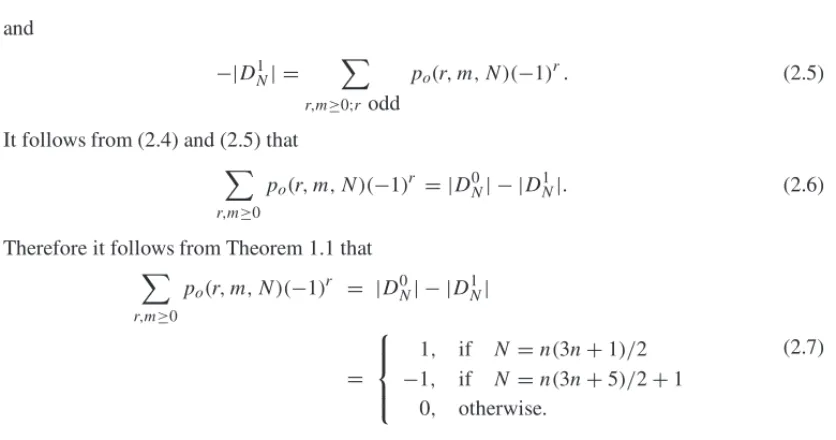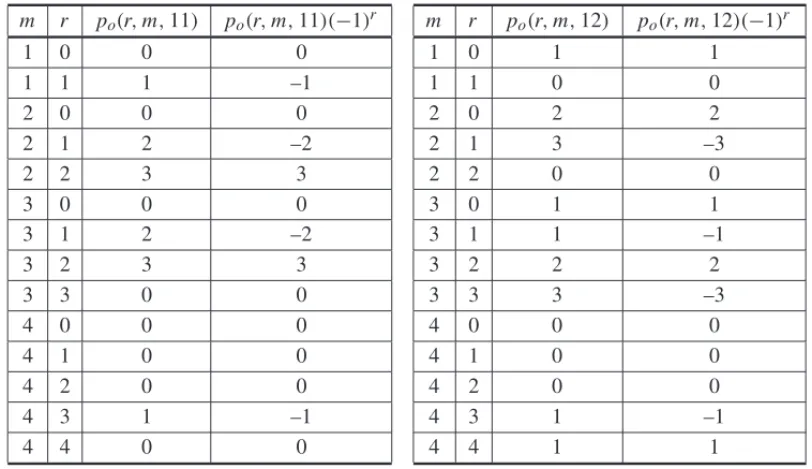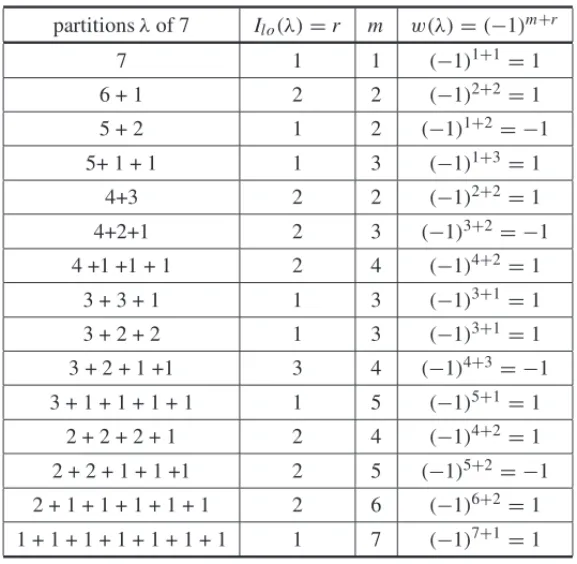Parity Indices and Two-Line Matrix Representation for Partitions
I.M. CRAVEIRO1*, A. WAGNER2 and D. DOMINGUES3
Received on November 6, 2014 / Accepted on October 28, 2015
ABSTRACT.In this work we present a solution for Andrews’s Problem 5 [1] by establishing a bijection between the setsD0nandD1ndefined in Fine’s Theorem [8] and the sets of partitions indexed by their lower parity index [1]. We also solve Andrews’s Problem 6, conjectured in [1].
Keywords:partition, parity index, mock theta function.
1 INTRODUCTION
In this section we present one of Fine’s renowned theorems. Its combinatorial proof can be found in [8]. That proof does not use complicated analytic formulae and its popularization oc-curred because of its elegance and simplicity, being similar to the famous involutive proof by Franklin. Franklin’s involution was used in many occasions to prove several refinements of Euler’s Pentagonal Number Theorem [7].
Theorem 1.1 (Fine). Let D0nand D1nbe the sets of partitions of n into distinct parts, such that the largest part a(λ)=λ1is even and odd, respectively. Then
|D0n| − |Dn1| =
⎧ ⎪ ⎪ ⎪ ⎨ ⎪ ⎪ ⎪ ⎩
1, if n= k(3k+1)
2 ;
−1, if n= k(3k−1)
2 ;
0, otherwise.
Problems that involve parity are related to classic partition identities such as Euler’s, Rogers’s, Ramanujan’s and Gordon’s identities. The theorem we just stated is an example of a problem that involves the concept of parity in the study of identities related to Partition Theory. Several authors
*Corresponding author: Irene Magalh˜aes Craveiro.
1Faculdade de Ciˆencias Exatas e Tecnologia – FACET, Universidade Federal de Grande Dourados – UFGD, Caixa Postal 364, 79084-970 Dourados, MS, Brasil. E-mail: irenecraveiro@ufgd.edu.br
2DMA-IMECC, Universidade de Campinas – Unicamp, 13083-859 Campinas, SP, Brasil. E-mail: dricawagner@gmail.com
studied questions that involve parity in partitions, [4], [5], [6]. In [1], Andrews described several results on this subject. At the end of the same work he enumerated fifteen problems. Problems 1, 2 and 3 were solved in [10]. Problems 9 and 10 were solved in [12], with a purely analytic solution. In [11] other solutions for problems 9 and 10 are presented, and in the same paper a proof for problem 5 is given, which is based on some results related to generating functions for partitions and q-series. In [9] there is also a solution to problem 5, based on the involutive proof by Franklin, 1881.
In section 2 we present a solution to Problem 5 establishing a bijection between the setsDn0and
Dn1defined on Fine’s Theorem and the sets of partitions indexed by their lower odd parity index [1]. In section 4 we present a solution for Problem 6, conjectured in [1].
We adopt the standardq-series notation: for each integern >0 define
(a)n =(a;q)n= n−1
j=0
(1−aqj)and(a;q)0=1.
2 LOWER INDEX AND FINE’S THEOREM
Definition 2.1.Letλbe a partitionλ=λ1+λ2+ · · · +λj, where λ1≥λ2≥ · · · ≥λj >0.
The lower odd parity index ofλ, denoted by Ilo, is defined as the maximum length of the
subse-quences of{λ1, λ2,· · ·, λj}whose terms alternate in parity beginning with an oddλi.
Example. Considerλ=8+7+7+6+5+4+4+2+2+1 a partition of 46. Thus,Ilo(λ)=6.
We will denote by po(r,m,n)the number of partitions ofninmdistinct parts withIlo(λ)equals
tor. Besides, Po(y,x;q)is the generating function for partitionsλofn intom distinct parts
withIlo(λ)=r, that is,
Po(y,x;q)= r,m,n≥0
po(r,m,n)yrxmqn (2.1)
The next result, given in [1], provides an explicit formula forPo(y,x;q).
Theorem 2.1.The generating function for partitions enumerated by po(r,m,n)is given by:
Po(y,x;q)= n≥0
xnynqn(n2+1)−q
y n (q2;q2)
n
. (2.2)
Evaluating (2.1) and (2.2) iny= −1 andx=1 we have:
Po(−1,1;q)= r,N≥0
po(r,m,N)(−1)rqN = n≥0
(−1)nqn(n2+1)(q;q)n
(q2;q2)
n
Problem 5 in [1] asks for a combinatorial proof for:
r,m≥0
po(r,m,N)(−1)r = ⎧ ⎪ ⎨ ⎪ ⎩
1, if N =n(3n+1)/2 −1, if N =n(3n+5)/2+1
0, otherwise .
The following lemma is very useful to solve Problem 5.
Lemma 2.1.Considerλ=λ1+λ2+ · · · +λma partition of the positive integer N in m distinct
parts, with Ilo(λ)=r andλ1> λ2>· · ·> λm. Then r is even (odd) if, and only if,λ1is even
(odd).
Proof. Letλ = λ1+λ2+ · · · +λm be a partition of the positive integer N in m distinct
parts, with Ilo(λ) = r, λ1 > λ2 > · · · > λm andr even. Hence there exists an increasing
subsequence of{λ1, λ2, . . . , λm}, whose length is equal tor,(λi+r−1, . . . λi+1, λi)with an odd λi+r−1. Becauseλi+r−1is odd andris even, thenλiis even. In the same way, we can conclude
that ifλi is even, thenris even, because otherwiseλi+r−1would be even, a contradiction. Ifλ1=λi then the proof is over. Suppose, then, thatλ1> λi.
For alli > j, we have thatλj is even. Ifλj is odd we have one more term of the sequence
that alternates parity withλi, which is even, and so the subsequence has lengthr+1. However
Ilo(λ)=r. Thereforeλjis even. It follows from taking j=1 thatλ1is even.
Conversely, suppose thatλ1is even. Suppose by absurd thatIlo(λ)=rwith an oddr, then there
exists a subsequence ofλ,(λi+r−1, . . . λi+1, λi), with an oddλi+r−1, andrbeing the maximum with this property. Henceλi is odd. We have thatλ1 =λi, becauseλ1is even. Sinceλi must
alternate parity withλ1we have thatIlo(λ)≥r+1. Thereforerif even. It is similar in the case
r is an odd number.
We will denote the set of partitions of a positive integerN, with distinct parts, whose lower odd parity index isIlo(λ)=r by:PNr . Whenr is even we use the notationP0N, and whenr is odd,
the notationP1 N.
It follows from Lemma 2.1 that given a partitionλ=λ1+λ2+ · · · +λmof the positive integer
Ninmdistinct parts withIlo(λ)=randλ1> λ2>· · ·> λm, then: λ∈P0
N if, and only if,λ∈ D
0
N.
In the same way, it follows from Lemma 2.1 that
λ∈P1
N if, and only if,λ∈ D1N.
This result establishes a 1-1 correspondence between the sets defined on Fine’s Theorem and the set of partitionsλindexed byIlo(λ)=r. So we can conclude that
|D0N| =
r,m≥0;r even
and
−|D1N| =
r,m≥0;rodd
po(r,m,N)(−1)r. (2.5)
It follows from (2.4) and (2.5) that
r,m≥0
po(r,m,N)(−1)r = |D0N| − |D1N|. (2.6)
Therefore it follows from Theorem 1.1 that
r,m≥0
po(r,m,N)(−1)r = |D0N| − |D1N|
=
⎧ ⎪ ⎨ ⎪ ⎩
1, if N =n(3n+1)/2 −1, if N =n(3n+5)/2+1
0, otherwise.
(2.7)
Therefore we have another solution for Andrews’s Problem 5, [1].
Example. Let N =11,12,mdenote the number of distinct parts of a partitionλofN andr
be its lower odd parity index.
Table 1: Distinct partitions of 11 and 12.
11 10 + 1
9 + 2 8 + 3 7 + 4 6 + 5 8 + 2 + 1 7 + 3 + 1 6 + 4 + 1 6 + 3 + 2 5 + 4 + 2 5 + 3+ 2+ 1
12 11 + 1 10 + 2 9 + 3 8 + 4 7 + 5 9 + 2 + 1 8 + 3 + 1 7 + 4 + 1 7 + 3 + 2 6 + 5 + 1 6 + 4 + 2 5 + 4 + 3 6 + 3 + 2 + 1 5 + 4 + 2 + 1
It follows from equation (2.7)
r,m≥0
and
r,m≥0
po(r,m,12)(−1)r = −1.
In particular see casesn =11 andn =12, respectively in Table 2.
Table 2: The values of po(r,m,N), whereN =11 andN =12, respectively.
m r po(r,m,11) po(r,m,11)(−1)r
1 0 0 0
1 1 1 –1
2 0 0 0
2 1 2 –2
2 2 3 3
3 0 0 0
3 1 2 –2
3 2 3 3
3 3 0 0
4 0 0 0
4 1 0 0
4 2 0 0
4 3 1 –1
4 4 0 0
m r po(r,m,12) po(r,m,12)(−1)r
1 0 1 1
1 1 0 0
2 0 2 2
2 1 3 –3
2 2 0 0
3 0 1 1
3 1 1 –1
3 2 2 2
3 3 3 –3
4 0 0 0
4 1 0 0
4 2 0 0
4 3 1 –1
4 4 1 1
3 PROBLEM 6 GIVEN IN [1]
The main goal of this section is to present a solution to Andrews’s Problem 6, [1].
Definition 3.1. Given a partitionλof a positive integer n = λ1+λ2+ · · · +λm with λ1 ≥
λ2 ≥ · · · ≥λm,whose lower odd parity index equals to Ilo(λ) =r, the weight ofλ, denoted
byw(λ)is the real number given by(−1)r+m.
Lemma 3.1. Considerλ = λ1+λ2+ · · · +λm a partition of the positive integer N , with
Ilo(λ)=r andλ1≥λ2≥ · · · ≥λm. Then: r is even (odd) if, and only if,λ1is even (odd).
Proof. The proof of this lemma is similar to the proof of Lemma 2.1.
It follows from Lemma 3.1 that given any partitionλof a positive integer N,
In the following table we describe partitionsλof 7 with its respectives Ilo(λ) =r, number of
partsmand weightsw(λ).
It follows from [1] that
Uo(y,x;q)= r,m,n≥0
uo(r,m,n)yrxmqn (3.1)
is the generating function for the partitionsλof the positive integern in exactlymparts, with
Ilo(λ)=r. Evaluating (3.1) inx=y= −1 we have:
Uo(−1,−1;q)= r,m,n≥0
uo(r,m,n)(−1)m+rqn. (3.2)
Observe that the coefficient of q7 in (3.2) is given by
r,m,≥0uo(r,m,7)(−1)m+r. This is
equivalent to sum the elements in the fourth column of Table 3, which in this case equals to 7.
Table 3: Partitions of 7 with its respectivesIlo(λ)=r.
partitionsλof 7 Ilo(λ)=r m w(λ)=(−1)m+r
7 1 1 (−1)1+1=1
6 + 1 2 2 (−1)2+2=1
5 + 2 1 2 (−1)1+2= −1
5+ 1 + 1 1 3 (−1)1+3=1
4+3 2 2 (−1)2+2=1
4+2+1 2 3 (−1)3+2= −1
4 +1 +1 + 1 2 4 (−1)4+2=1
3 + 3 + 1 1 3 (−1)3+1=1
3 + 2 + 2 1 3 (−1)3+1=1
3 + 2 + 1 +1 3 4 (−1)4+3= −1
3 + 1 + 1 + 1 + 1 1 5 (−1)5+1=1
2 + 2 + 2 + 1 2 4 (−1)4+2=1
2 + 2 + 1 + 1 +1 2 5 (−1)5+2= −1
2 + 1 + 1 + 1 + 1 + 1 2 6 (−1)6+2=1
1 + 1 + 1 + 1 + 1 + 1 + 1 1 7 (−1)7+1=1
In [2] it is given a bijection between the set of unrestricted partitions and two-line matrices A
defined as:
A=
c1 c2 . . . cl
d1 d2 . . . dl
whose entries satisfy
cl >0
ct ≥2+ ct+1+dt+1 witht<l
,
withct,dt ≥0 andn=li=1(ci+di). Matrices defined in this way are presented as:
A=
(2l−1)+ j1+. . .jl+d2+ · · · +dl . . . 3+ jl−1+jl+dl 1+jl
d1 . . . dl−1 dl
,
l ≥1,s,d1, . . . ,dl,j1, j2, . . . ,jl ∈N.
Given a partitionλof a integern,n=λ1+λ2+ · · · +λm, the procedure to obtain the matrixA
fromλ[2] is given below:
• the sidelof the Durfee square is the number of columns of the matrix;
• the parametersd1,d2, . . . ,dlindicate the amount of parts 1′s,2′s, . . .l′s, respectively, that
appear below the Durfee square of sidel.
⎧ ⎪ ⎪ ⎪ ⎪ ⎨ ⎪ ⎪ ⎪ ⎪ ⎩
λ1=l+ j1+ j2+ · · · + jl ..
.
λl−1=l+jl−1+jl λl =l+ jl
,
where j1, j2, . . . ,jlare obtained in the solution of the system: ⎧
⎪ ⎪ ⎪ ⎪ ⎨ ⎪ ⎪ ⎪ ⎪ ⎩
c1=(2l−1)+ j1+ j2+. . . jl+d2+ · · · +dl ..
.
cl−1=3+jl−1+ jl+dl
cl =l+ jl
.
In [3], the weight of the matrix A, given in (3.3) is defined byw(A) =(−1)c1+d1+1. We will
check that the weight of the matrixAhas the same weight of the partitionλ, associated to Aby means of the bijection given in [3]. Indeed,c1+d1+1=(2l−1)+j1+. . .jl+d2+· · ·+dl+d1+ 1=2l+j1+. . .jl+d1+d2+ · · ·+dl =(l+j1+. . . jl)+(l+d1+d2+ · · · +dl). Observe that
the greatest part of the partition isλ1=l+j1+. . .jland the number of parts of the partition is:
m=l+d1+d2+ · · · +dl. Therefore,w(A)=(−1)c1+d1+1=(−1)λ1+m =(−1)r+m =w(λ),
wherer=Ilo(λ). It follows from [3] that
Theorem 3.1. The third order mock theta function f(q) = ∞ n=0
qn2
(−q;q)2
n
, is the generating function for the weighted number of matrices A of the form (3.3). Where matrix is to be counted with the weightw(A)=(−1)c1+d1+1.
Theorem 3.2. The third order mock theta function f(q) = ∞ n=0
qn2
(−q;q)2
n
, is the generating function for the weighted number of unrestricted partitionsλ=λ1+λ2+· · ·+λmwith Ilo(λ)=r.
Where each partition is to be counted with the weightw(λ)=(−1)m+r and m is the number of parts. From this from Theorem we have then, that
Uo(−1,−1;q)= r,m,n≥0
uo(r,m,n)(−1)m+rqn=
∞
n=0
qn2
(−q;q)2
n
RESUMO.Neste trabalho apresentamos uma soluc¸˜ao para o Problema 5 de Andrews [1] por
meio de uma bijec¸˜ao entre os conjuntosD0nandD1ndefinidos no Teorema de Fine [8] e os conjuntos das partic¸ ˜oes indexadas pelo ´ındice de paridade inferior [1]. Tamb´em resolvemos o Problema 6 de Andrews, conjecturado em [1].
Palavras-chave:partic¸ ˜ao, ´ındice de paridade, mock theta function.
REFERENCES
[1] G.E. Andrews. Parity in partition identities.Ramanujan Journal,23(2010), 45–90.
[2] E.H.M. Brietzke, J.P.O. Santos & R. Silva. Bijective proofs using two-line matrix representation for partition.Ramanujan Journal,23(2010), 265–295.
[3] E.H.M. Brietzke, J.P.O. Santos & R. Silva. Combinatorial interpretations as two-line array for the mock theta functions.Bulletin Brazilian Mathematical,44(2013), 233–253.
[4] H. G¨ollnitz. “Einfache Partionen”. Thesis, G¨ottingen, (1960).
[5] H. G¨ollnitz. Partitionen mit Differenzenbedingungen.J. Reine Angew. Math.,225(1967), 154–190.
[6] B. Gordon. Some continued fractions of the Rogers-Ramanujan type. Duke Math J., 31 (1965), 741–748.
[7] I. Martinjak. Refinements and Extensions of the Euler Partition theorem. http://imartinjak.files.wordpress.com/2013/06/refinementslecturenotes1.pdf.
[8] I. Pak. On Fine’s partition theorems, Dyson, Andrews and missed opportunities.Mathematical Intel-ligencer,25(1) (2003), p. 10.
[9] R. Silva, J.C. Filho & J.P.O. Santos. Proving Two Partition Identities.TEMA,13(2) (2012), 133–142.
[10] A.J. Yee & S. Kim. G¨ollnitz-Gordon Identities and Parity Questions in Partitions.European Journal of Combinatorics,32(2) (2011), 288–293.
[11] A.J. Yee. Ramanujan’s partial theta series and parity in partitions.The Ramanujan Journal,23(2010), 215–225.


